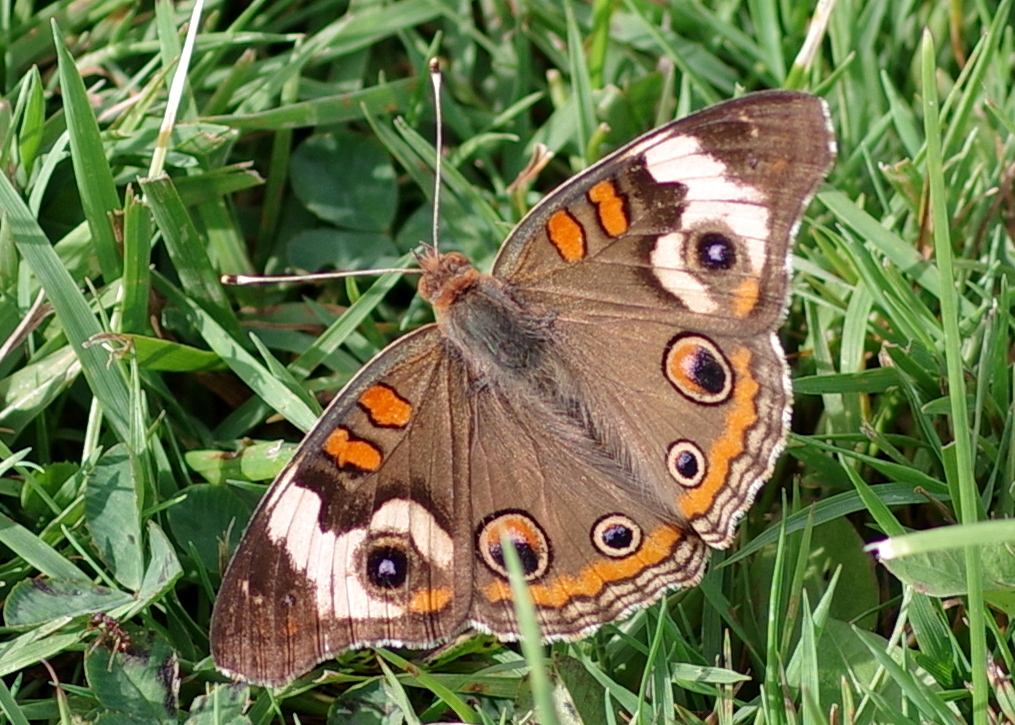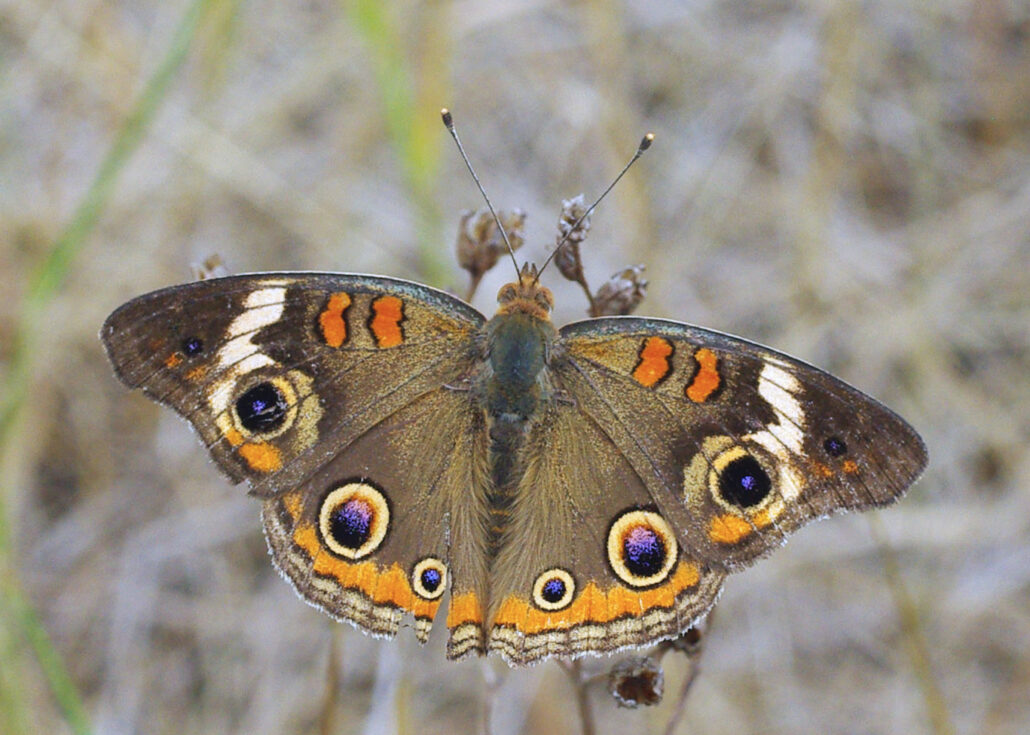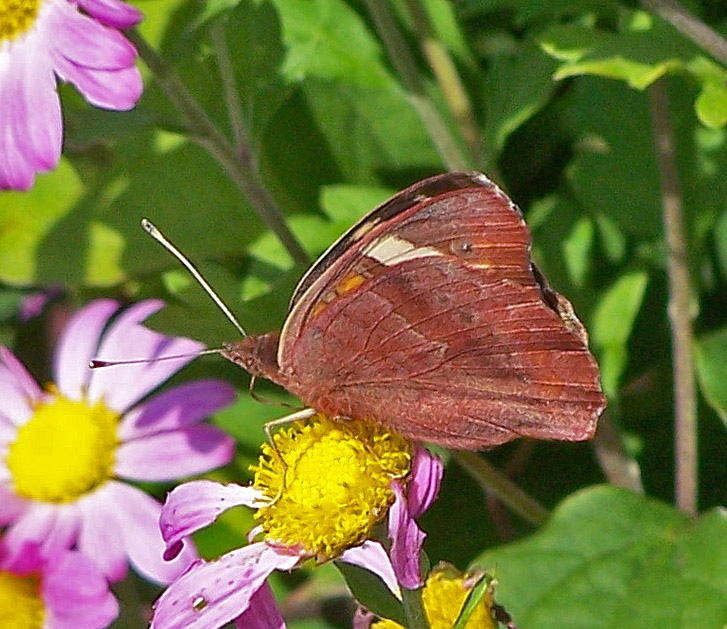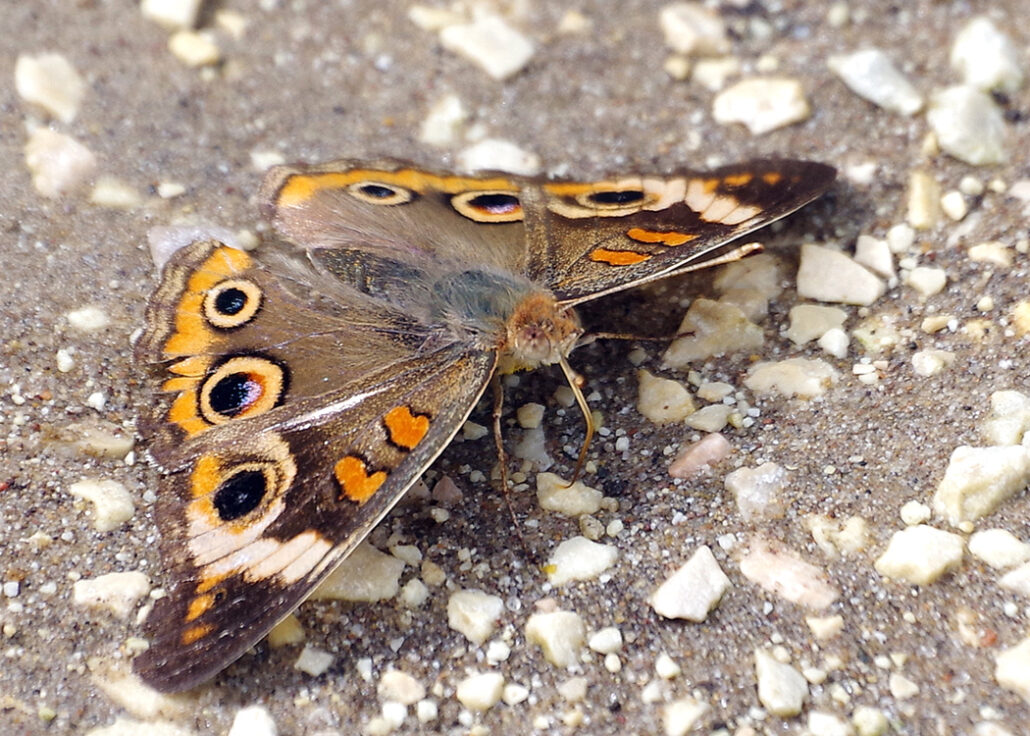
by Kate Redmond
Common Buckeye Butterfly rewrite
Howdy, BugFans,
The BugLady originally wrote about the Common Buckeye in January of 2009, but she thinks she might have given it short shrift (due to insufficient scholarship), so here’s a rewritten version with new words and new pictures.
The first thing to know about Common Buckeyes is that they are not Yankee butterflies – they are Southerners (from a largely tropical genus) that recolonize God’s Country in varying numbers from year to year and produce a two or three broods here, depending on whether spring and/or fall is long and mild. But they are not very “freeze-tolerant,” and they can’t survive Wisconsin winters in any stage, so they wander back south in the fall. Brock and Kaufman, in their Field Guide to Butterflies of North America, report that fall migrations of Common Buckeyes, especially on the Atlantic coast, can be spectacular. The BugLady saw some out on the prairie as recently as a week ago – they always see her and her camera before she sees them (with their wings closed, they’re pretty well camouflaged), and they fly farther down the trail to wait for her.
The Common Buckeye (Junonia coenia, aka Precis coenia) (not the Ohio buckeye – that’s a tree) belongs to the Order Lepidoptera (“scaled wings”) which includes the butterflies and the moths. Of the 12,000 species of Lepidoptera in North America north of Mexico, only about 700 are butterflies. Along with the usual six-legs-three-body-parts insect stuff, moths and butterflies have in common four wings that are covered with easily-rubbed-off scales (the upper surface of a butterfly’s wing often has a different pattern then the lower surface does), and mouthparts in the form of a coiled tube called a proboscis that is used for feeding on liquids like nectar and sap. Caterpillars chew; butterflies and moths sip.
Rules of thumb for telling them apart are that (generally) butterflies sit with their wings held out to the side or folded vertically above their bodies, and moths hold their wings flat over or wrapped around their body. Butterflies have a thickened tip/knob on the end of their antennae; moths’ antennae may be bare or feathery but are never knobbed. Butterflies are active by day (though the BugLady had night-feeding Northern Pearly-eye butterflies who hadn’t read that part of the playbook), and moths are generally active in late afternoon and through the night. Some moths have bright colors and patterns, but as a group, they tend to be drab – what birders call “LBJ’s” – “Little Brown Jobs.” Because of their pigmented and/or prismatic scales, many butterflies are the definition of the word “dazzling.”





Buckeyes belong to the “Brush-footed butterfly” family Nymphalidae, a large group of strong, colorful fliers whose front legs are noticeably hairy and are reduced in size (leading to another nickname – “four-footed butterflies”). There are a number of brush-foots that migrate and others that, contrary to the usual insect practice, overwinter as adults. Many Nymphalid caterpillars are nocturnal and spiny.
The “Butterflies of Massachusetts” website says of this beautiful butterfly that “The Halloween-costumed Buckeye wears the colors of fall in New England.” Buckeyes are named for the eyespots on their wings, which are reminiscent of the spots on buckeye nuts. Many members of the genus Junonia have eyespots to scare away predators, and an eyespot can even be seen in the Buckeye’s pupal wing case.
Both the caterpillar and the adult are variable in color – an adult whose underwing surface is tan is from an early summer generation, and one whose underwing is rosy is from the final brood of the year – the color change is controlled by genes and is a response to the temperatures that the caterpillar is exposed to. There is no other butterfly species in Wisconsin that can be mistaken for them.
Buckeyes are sun-lovers, butterflies of sunny habitats like open fields, disturbed areas, trails, edges, and grassy dunes, where they often perch on the ground. “Butterflies of Massachusetts” speculates that this species has become more common since the European settlers cleared the great forests for agriculture, and notes that it is one of our native butterflies that has adopted a non-native “weed” (English plantain) as a food plant. Adults sip nectar from dogbanes and from those confusing fall composites (asters and goldenrods), and they sip fluids from decaying fruit.
Males are feisty and territorial, chasing other flying objects, both butterfly and non-butterfly alike. He scouts for females from a perch on the ground or on low vegetation. After mating, females oviposit on leaves and leaf buds of host plants – mostly members of the plantain (the lawn plant, not the banana relative) and snapdragon families. Caterpillars https://bugguide.net/node/view/1939097/bgimage are solitary and non-aggressive, even when they bump into another caterpillar on the same plant. The pupae https://bugguide.net/node/view/2214613/bgimage are said to look like bird poop (pretty fancy bird poop, indeed!).
Caterpillar food plants often contain toxic chemicals (iridoid glycosides) that besides being very bitter, will literally stunt the growth of a predator that eats a caterpillar – chemicals that, conversely, make the caterpillars hungry. Chemicals that, when the female senses them, will stimulate her to oviposit. Predators seem to sense the presence of the glycosides and prefer caterpillars with low/no levels of them. Caterpillars must be careful of getting too much of a good thing – excessive amounts of iridoid glycosides can affect their immune system negatively.
Ain’t Nature Grand!
Kate Redmond, The BugLady
Bug of the Week archives:
http://uwm.edu/field-station/category/bug-of-the-week/
